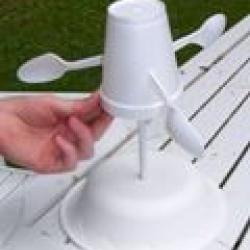Source Institutions
Source Institutions
Add to list Go to activity
Activity link broken? See if it's at the internet archive

In this activity, learners explore how anemometers work to record wind speeds and how the equipment has undergone engineering adaptations over time. Learners work in teams of "engineers" to design and build their own anemometer out of everyday items. Learners test their sensors, evaluate their results, and present reflections to the group.
- Under 5 minutes
- 1 to 2 hours
- Over $20 per group of students
- Ages 8 - 18
- Activity, Experiment/Lab Activity, Lesson/Lesson Plan
- English
Quick Guide
Materials List (per group of students)
- Student Resource Sheets
- Student Worksheets
- Hairdryer or fan with multiple speed settings (or if your are in a windy environment, this lesson can be completed outside)
- Foil
- Plastics
- Paper cups
- String
- Tape
- Wire
- Straws
- Wooden sticks
- Small wooden spoons
- Small wooden (balsa) pieces
- Bendable wire (such as florist or craft wire)
- Paperclips
- Rubber bands
- Toothpicks
- Aluminum foil
- Glue
- Paper
- Cardboard
- Plastic wrap
- Other materials as needed
- Graph paper for documentation of results
Subjects
-
Earth and Space Science
-
Earth Processes
- Weather and Climate
-
Earth Structure
- Atmosphere
-
Earth Processes
-
Engineering and Technology
-
Engineering
- Mechanical Engineering
- Metallurgy and Materials Engineering
- Technology
-
Engineering
-
Mathematics
-
Data Analysis and Probability
- Data Analysis
- Data Collection
-
Measurement
- Rate
-
Data Analysis and Probability
-
Physical Sciences
- Energy
-
Motion and Forces
- Machines
- Momentum and Velocity
- Rotation Motion
-
Structure and Properties of Matter
- Mass and Weight
- Volume and Density
-
The Nature of Science
-
The Scientific Process
- Conducting Investigations
- Gathering Data
- Formulating Explanations
- Communicating Results
-
The Scientific Process
-
The Nature of Technology
-
Technology and Society
- Technology and the Environment
- Technology and History
-
The Design Process
- Research and Development
- Invention and Innovation
- Problem Solving
- Troubleshooting and Maintenance
-
Technology and Society
Informal Categories
- Nature and Environment
- Outdoor Activity
Audience
To use this activity, learners need to:
- see
- read
- touch
Learning styles supported:
- Involves teamwork and communication skills
- Involves hands-on or lab activities
Other
Components that are part of this resource:
Includes alignment to state and/or national standards:
This resource is part of:
Access Rights:
- Free access
By:
Rights:
- All rights reserved, IEEE,
